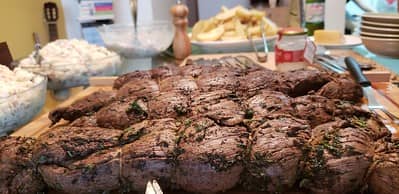
Seasoning roast beef properly is essential to enhance its flavor and create a delicious, tender, and juicy roast. This detailed article will teach you everything you need to know about seasoning roast beef:
What’s the best cut for roast beef?
Choosing the right cut of beef is crucial for a successful roast. Some popular meat choices to buy include ribeye, sirloin, top round, and tenderloin. Ultimately the ideal cut depends on your preferences, but in general, a well-marbled cut like ribeye produces the juiciest results enjoyed by all.
What’s the secret to cooking tender roast beef?
Apart from seasoning, achieving tender roast beef depends on several factors like cooking time and temperature. You should also always use a meat thermometer to ensure the beef reaches safe temperatures inside the meat and that your desired level of doneness is achieved. Resting the roast before slicing is also crucial for the juices to redistribute within the fibers and ensure tenderness.
Roast Beef Rub
A basic roast beef rub can include a combination of the following ingredients:
- Salt
- Pepper (freshly cracked is best)
- Garlic powder or minced garlic
- Onion powder
- Dried herbs like thyme, rosemary, and oregano
- Olive oil or melted butter for basting
There’s also no harm in using store-bought rubs especially if you’re pressed for time or cooking a large batch for several people.
Classic Roast Beef Recipe
Ingredients
- 3-4 lbs of beef roast
- Roast beef rub (as mentioned earlier)
- Olive oil or melted butter for basting
Instructions
- Preheat your oven to 325°F (163°C).
- Rub the roast beef generously with your seasoning mix, making sure you cover all of the sides evenly.
- Heat a heavy oven-safe skillet or roasting pan over medium-high heat. Add a bit of oil with a high smoking point.
- Sear the roast on all sides until it develops a rich brown crust, about 2-3 minutes per side, regardless of how thick the cut is.
- Transfer the roast to the preheated oven and roast until your desired level of doneness (use an easy-read meat thermometer to check). For medium-rare, it’s about 135°F (57°C) internal temperature.
- Baste the roast with olive oil or melted butter occasionally during cooking to keep it moist.
- Once the meat is cooked, remove it from the oven and tent with aluminum foil to keep the moisture inside the meat. Allow it to rest for at least 15 minutes before slicing and plating.
Roast Beef Seasoning Tips
- Don’t be afraid to experiment with spices and even cuts of meat until you find a combination that works for you and your regular guests.
- Learn how to gauge the freshness of meat so you can always buy cuts that will yield the best results.
Classic Roast Beef – Nutritional Facts
Per Serving (based on 6 servings, based on a 2,000-calorie daily diet)
| Nutrient | Amount (% Daily Value (DV)) |
|---|---|
| Calories | 460 (23%) |
| Total Fat | 32g (41%) |
| Saturated Fat | 12g (60%) |
| Trans Fat | 1.5g |
| Cholesterol | 120mg (40%) |
| Sodium | 620mg (27%) |
| Total Carbohydrate | 1g (0%) |
| Dietary Fiber | 0g (0%) |
| Total Sugars | 0g |
| Added Sugars | 0g (0%) |
| Protein | 38g (76%) |
| Vitamin D | 0.2mcg (1%) |
| Calcium | 22mg (2%) |
| Iron | 3.8mg (21%) |
| Potassium | 590mg (13%) |
Final Thoughts
Seasoning roast beef is a creative process, and you can experiment with different herbs and spices to develop your unique flavor profile. Just remember the basics of choosing the right cut, using quality seasonings, and controlling cooking time and temperature for the perfect roast beef. Enjoy your delicious meal!
Beef Roast Seasoning FAQs

Classic Roast Beef
Ingredients
- 3-4 lbs beef roast
- roast beef rub (as mentioned earlier)
- olive oil or melted butter for basting
Instructions
- Preheat your oven to 325°F (163°C).
- Rub the roast beef generously with your seasoning mix, making sure you cover all of the sides evenly.
- Heat a heavy oven-safe skillet or roasting pan over medium-high heat. Add a bit of oil with a high smoking point.
- Sear the roast on all sides until it develops a rich brown crust, about 2-3 minutes per side, regardless of how thick the cut is.
- Transfer the roast to the preheated oven and roast until your desired level of doneness (use an easy-read meat thermometer to check). For medium-rare, it's about 135°F (57°C) internal temperature.
- Baste the roast with olive oil or melted butter occasionally during cooking to keep it moist.
- Once the meat is cooked, remove it from the oven and tent with aluminum foil to keep the moisture inside the meat. Allow it to rest for at least 15 minutes before slicing and plating.

